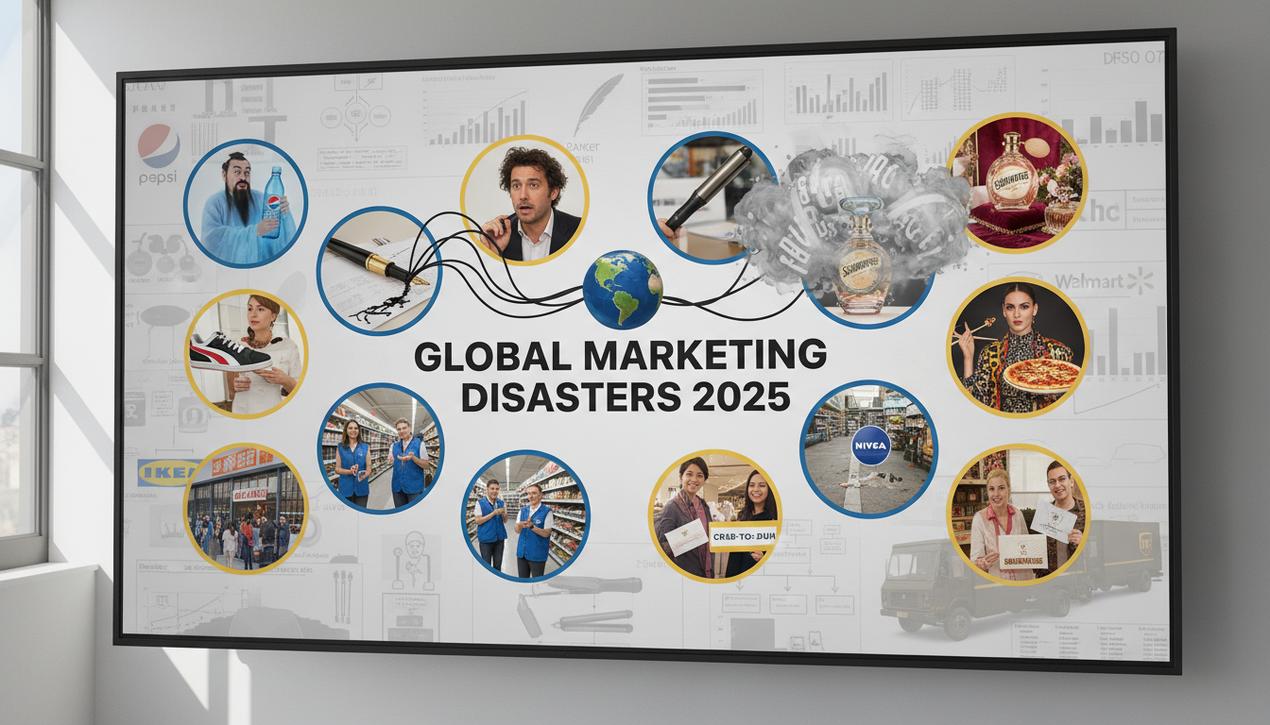12 Major International Marketing Fails to Avoid


Going global is the ultimate goal for many companies, promising significant growth and access to new markets. In 2025, global digital ad spending is projected to exceed $700 billion, creating a massive playground for ambitious brands. However, this path is fraught with cultural, linguistic, and strategic pitfalls. A poorly adapted campaign can not only fail but also cause irreparable damage to a brand’s reputation. Studies show that over 75% of consumers prefer to buy products with information in their native language, and a simple translation error can have disastrous consequences. Far from being mere anecdotes, international marketing failures are costly lessons, even for the world’s biggest brands. This article examines 12 iconic case studies that illustrate the blunders to avoid for a successful global expansion, a key challenge when you launch your startup internationally.
Why Cultural Adaptation Is Non-Negotiable in 2025
In the age of hyper-connectivity and social media, a marketing mistake can go viral in hours. The “one-size-fits-all” strategy is obsolete. The dominant trend is glocalization: thinking globally but acting locally. This means deeply adapting every aspect of the marketing strategy—from the product name and color choices to the messaging tone and communication channels, including local approaches like impactful street marketing ideas. Ignoring cultural nuances is no longer an option. Consumers in 2025 demand authenticity and expect brands to understand and respect their values, traditions, and customs. A campaign that works in New York can be a complete disaster in Beijing or Riyadh. The challenge isn’t just selling a product; it’s about building a trusting relationship with a new audience.
Literal Translation Errors: When Slogans Go Wrong
Translation is often the first step in internationalization, and also the first source of embarrassing mistakes. A word-for-word translation that ignores context and idioms can turn a powerful slogan into a nonsensical or offensive phrase.
1. Pepsi in China: The Promise to Raise the Dead
In the 1960s, Pepsi launched a global campaign centered on its slogan, “Come Alive with the Pepsi Generation.” While the message was clear to Western audiences, its literal translation into Mandarin resulted in something far more unsettling: “Pepsi will bring your ancestors back from the dead.” This bold promise caused widespread confusion and ridicule in the Chinese market.
2. Parker Pen in Mexico: An Unexpected Pregnancy
Pen manufacturer Parker tried to reassure its Mexican customers with the slogan, “It won’t leak in your pocket and embarrass you.” The goal was to highlight the pen’s reliability. However, a translation error replaced “embarrass” with the false cognate “embarazar,” which means “to impregnate.” The ad ended up promising consumers: “It won’t leak in your pocket and get you pregnant.”
3. Schweppes in Italy: A Toilet Beverage?
While trying to promote its famous “Schweppes Tonic Water” in Italy, the brand made a simple but fatal translation mistake. The word “Water” was translated to “Acqua,” but in context, the campaign was understood as “Schweppes Acqua da Toilette,” which means “Schweppes Toilet Water.” Not exactly an appealing description for a refreshing drink.
4. Clairol in Germany: The Manure Stick
The hair care company Clairol attempted to launch its curling iron, the “Mist Stick,” in the German market. Unfortunately, they hadn’t done their linguistic homework. In German slang, the word “Mist” means “manure” or “dung.” Unsurprisingly, selling a “Manure Stick” proved to be very difficult.
Cultural Insensitivity: Ignoring Local Symbols and Customs
Beyond words, images, colors, symbols, and customs carry deep meanings that vary across cultures. Ignoring them is a recipe for disaster.
5. Dolce & Gabbana in China: The Chopsticks Fiasco
In 2018, the Italian luxury brand released a series of promotional videos showing a Chinese model attempting to eat Italian food with chopsticks, in a tone widely perceived as condescending and mocking. The campaign was seen as racist and disrespectful to Chinese culture. The ensuing scandal led to a massive boycott of the brand, the removal of its products from Chinese e-commerce platforms, and a long-lasting stain on its image in the country.
6. Puma in the UAE: The Flag on an Unclean Object
To celebrate the 40th anniversary of the United Arab Emirates, Puma released a special edition sneaker featuring the colors of the national flag. The intention was good, but it ignored a major cultural taboo. In Arab culture, shoes and feet are considered unclean. Associating the national flag, a sacred symbol, with a “dirty” object caused public outrage and forced the brand to quickly pull the product from the market.
7. Walmart in Germany: Too Many Smiles and Too Much Service
The American retail giant failed in its expansion into Germany for deep-seated cultural reasons. Employees, trained in the American style of customer service, were instructed to smile at customers, which was often misinterpreted as flirting. The practice of cashiers bagging customers’ groceries was also poorly received, as Germans prefer to do it themselves. These cultural clashes, combined with an ill-suited pricing strategy, led to billions in losses and Walmart’s withdrawal from the country.
8. Nivea in the Middle East: “White is Purity”
In a campaign aimed at its Middle Eastern customers, Nivea ran an ad for a deodorant with the slogan “White is Purity.” While the intent was likely to convey cleanliness, the message was immediately interpreted as having racist undertones, especially in a globally sensitive climate. Following a social media firestorm, the brand was forced to delete the campaign.
Product and Strategy Errors: A Concept Unfit for the Market
Sometimes, the problem isn’t the advertising but the product or business model itself, which simply doesn’t align with local consumer habits.
9. Home Depot in China: The DIY Culture That Wasn’t
Home Depot, the American king of “Do-It-Yourself” home improvement, tried to conquer the Chinese market using the same model. It was a complete failure. In China, labor is affordable, and the culture embraces a “Do-It-For-Me” mindset. Chinese consumers would much rather hire professionals for home projects than spend their weekends on DIY tasks. The company had to close all its big-box stores.
10. Ikea in Thailand: Embarrassing Product Names
Ikea’s strategy of giving its products Swedish names is part of its brand identity. But in Thailand, this approach led to some awkward situations. Some product names, like “Redalen” and “Jättebra,” sounded phonetically similar to Thai slang expressions with strong sexual connotations. The company had to hire linguists to adapt the names and avoid further misunderstandings.
11. Hallmark in France: The Rejection of Pre-Written Messages
The American greeting card leader, Hallmark, experienced a crushing failure in France. Its core concept of cards with pre-written messages and poems clashed directly with French culture, which highly values personal expression and customized messages. French consumers disliked what they saw as a lack of authenticity and personal effort.
12. UPS in Europe: Unfortunate Uniforms and Vehicles
The delivery company UPS made several cultural blunders during its European expansion. In Germany, the brown uniforms of its drivers were uncomfortably reminiscent of the “Brownshirts,” a paramilitary wing of the Nazi party. In Spain, its delivery trucks, also brown, looked strikingly similar to local hearses, creating a rather grim association.
These examples demonstrate that a successful international marketing strategy requires far more than just translation. It demands a deep immersion into the local culture, intellectual curiosity, and a great deal of humility. To avoid these pitfalls, it is imperative to conduct thorough market research, collaborate with local experts, invest in transcreation (adapting the message, not just the words), and rigorously test every campaign with the target audience. In a globalized economy, cultural intelligence is no longer just an asset; it is a prerequisite for success, as are proven ways to thank customers.




